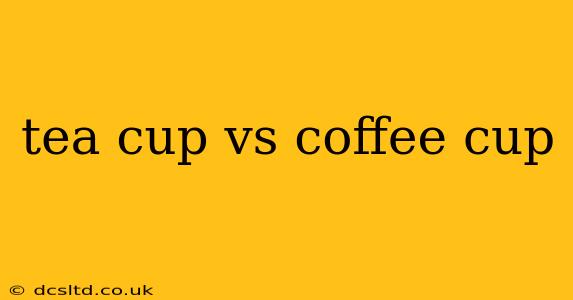Choosing between a tea cup and a coffee cup might seem simple, but there's more to it than meets the eye! The differences go beyond just the beverage they hold; they encompass design, size, material, and even the overall drinking experience. This comprehensive guide will delve into the nuances of tea cups and coffee cups, helping you select the perfect vessel for your favorite hot beverage.
What's the Difference Between a Tea Cup and a Coffee Cup?
The primary difference lies in size and shape. Coffee cups are generally larger and wider than teacups, designed to hold the larger volume typically associated with a coffee serving. Teacups, on the other hand, are smaller and often more delicate, reflecting the more nuanced and often smaller serving size of tea. The shape also plays a role; coffee cups tend towards a more cylindrical or slightly tapered design, while teacups often feature a more curved or flared shape, sometimes with a handle that's more elegantly designed.
What Size is a Standard Tea Cup?
A standard teacup typically holds between 6 and 8 ounces (177-237 ml). However, this can vary considerably depending on the style and manufacturer. Some teacups are smaller, while others might hold slightly more. The size often depends on the type of tea being served; a larger cup might be preferred for brewed tea, while smaller cups might be used for delicate, more concentrated teas.
What Size is a Standard Coffee Cup?
A standard coffee cup typically holds between 8 and 12 ounces (237-355 ml). Again, this is a general guideline; specialty coffee shops and home coffee enthusiasts may use mugs of varying sizes, sometimes significantly larger than 12 ounces, depending on the brewing method and individual preference.
Are Tea Cups and Coffee Cups Made of the Same Material?
While both teacups and coffee cups can be made from a variety of materials, including ceramic, porcelain, glass, and even stoneware, there are some subtle differences in common usage. Porcelain and fine bone china are popular choices for teacups, emphasizing their delicate nature and often contributing to a more refined drinking experience. Coffee cups, while often made of ceramic, might also utilize more durable materials like thicker stoneware or even stainless steel, reflecting the potential for more frequent and potentially rougher handling.
What is the Best Material for a Tea Cup?
The "best" material is subjective and depends on personal preference. However, porcelain and bone china are favored for their ability to retain heat, their elegant aesthetic, and their durability (when handled carefully). Glass teacups allow for appreciation of the tea's color, while stoneware offers a rustic and durable alternative.
What is the Best Material for a Coffee Cup?
Similarly, the ideal material for a coffee cup depends on individual preferences. Ceramic is a common and versatile choice, offering good heat retention and a variety of design options. Stoneware provides enhanced durability, and stainless steel keeps coffee hot for longer periods and is very easy to clean.
How to Choose the Right Cup for Your Drink?
Consider these factors:
- Beverage type: The size and shape of the cup should complement the beverage. Delicate teas benefit from smaller, more elegant cups, while robust coffees often suit larger, sturdier mugs.
- Personal preference: Ultimately, the best cup is the one you enjoy using the most. Consider factors like comfort, aesthetics, and heat retention.
- Occasion: A formal tea party might call for fine china teacups, while a casual morning coffee might be best enjoyed in a simple, durable mug.
By understanding the subtle differences between tea cups and coffee cups, you can choose the perfect vessel to enhance your enjoyment of your favorite hot beverage. From the delicate clinking of a fine china teacup to the comforting warmth of a stoneware coffee mug, the right cup can elevate the entire drinking experience.
